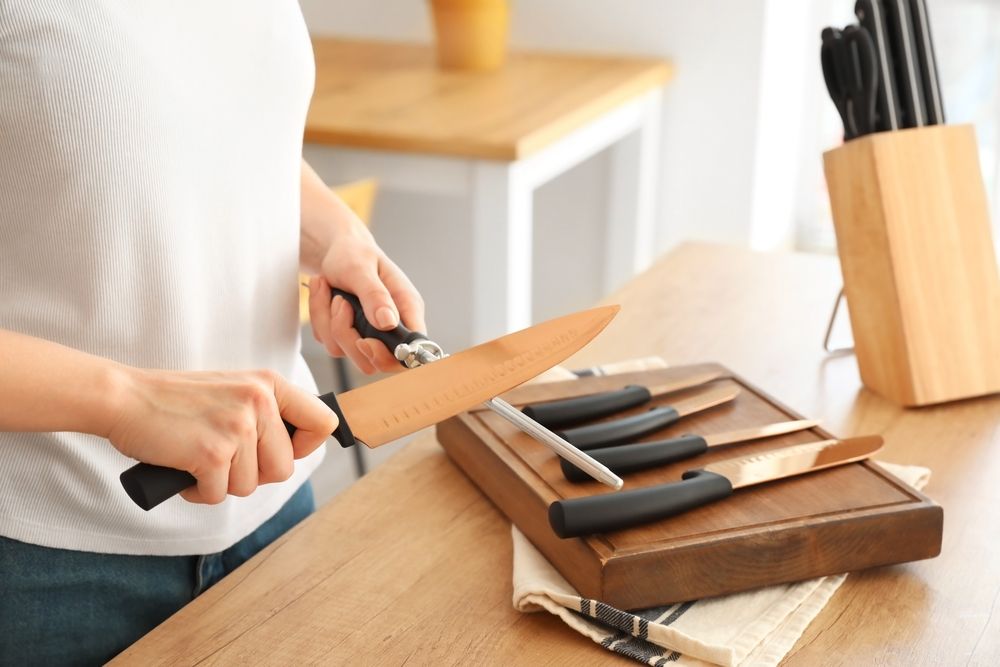Every home cook knows that having a good set of knives can make meal prep faster, easier, and safer. But with so many options available—from entry-level starter sets to high-end professional collections—it’s easy to feel overwhelmed when shopping for the right one. The key is to understand what you actually need, what makes a knife set reliable, and how to match features to your cooking style.
Whether you’re dicing vegetables, slicing meat, or simply spreading butter, here’s how to choose the best knife set to handle every task in your kitchen.
Know the Essentials in a Basic Knife Set
Not every set needs 15 pieces. Start by identifying the must-haves:
-
Chef’s Knife: The most versatile blade. Ideal for chopping, slicing, and dicing.
-
Paring Knife: Best for peeling, trimming, and precision cuts.
-
Serrated Knife: Perfect for bread, tomatoes, and citrus fruits.
-
Utility Knife: Fills the gap between a chef’s knife and a paring knife.
-
Kitchen Shears: Useful for cutting herbs, trimming fat, and opening packaging.
-
Knife Block or Storage: Keeps blades organized and protected.
Sets with only these essentials are often better than large collections filled with seldom-used pieces.
Understand the Types of Knife Blades
The two primary types of knife blades you’ll encounter are forged and stamped.
-
Forged blades are made from a single piece of steel, heated and shaped under pressure. They’re heavier, more durable, and offer excellent balance.
-
Stamped blades are laser-cut from sheets of steel. They’re usually lighter and more affordable but may not hold an edge as long as forged ones.
For everyday cooking, stamped blades are perfectly fine. If you want longevity and better performance, go forged.
Blade Material Matters
Knife blades are made from various materials, each with its own benefits:
-
Stainless Steel: Resistant to rust and easy to maintain. Great for home cooks.
-
High-Carbon Stainless Steel: Offers better edge retention and sharpness.
-
Ceramic: Ultra-sharp and lightweight, but can chip or break if dropped.
-
Damascus Steel: Known for its beautiful, wavy pattern and layered strength.
High-carbon stainless steel is the sweet spot for durability and ease of sharpening.
Consider the Handle Design
A knife should feel comfortable and secure in your hand. The handle affects both comfort and safety.
-
Wood handles look classic but may require more care.
-
Plastic or resin handles are low maintenance and lightweight.
-
Full tang construction (where the blade runs through the handle) offers better balance and stability.
Grip the knife in-store if possible. It should feel balanced, not too heavy at the blade or handle.
Look at Storage and Safety
Knife sets often come with a block, magnetic strip, or drawer tray. Storage isn’t just about organization—it keeps your knives sharper and your fingers safer.
-
Knife blocks: Most common; look for ones with horizontal slots to prevent dulling the blades.
-
Magnetic strips: Save counter space and offer quick access.
-
Drawer trays: Great for small kitchens, but require careful placement to avoid damage.
No matter what you choose, store your knives properly to extend their life.
Check for Knife Set Extras
Some knife sets come with bonus features that add real value.
-
Built-in sharpeners: Handy for quick touch-ups between serious sharpening.
-
Honings rods: Keep edges aligned for cleaner cuts.
-
Labelled slots in knife blocks: Helpful for beginners.
These extras aren’t necessary, but they can enhance your cooking experience and maintenance routine.
Match the Set to Your Cooking Style
Your ideal knife set should align with how and what you cook most often.
-
Vegetarian or plant-based diets: Focus on a sharp chef’s knife, paring knife, and utility blade.
-
Meat eaters or grill enthusiasts: Look for a set with a boning knife and carving knife.
-
Bakers: A good serrated bread knife is essential.
Think about the tasks you do daily. A set that supports your habits will serve you better than one with flashy specialty knives you rarely use.
Think About Maintenance
All knives require some level of care. Before purchasing, ask yourself how much effort you’re willing to put into upkeep.
-
Dishwasher-safe knives may seem convenient but often dull faster and corrode over time.
-
Hand-washing and drying is the best way to keep blades sharp and rust-free.
-
Sharpening frequency: Most home cooks can get by with sharpening 2–4 times a year, depending on use.
Pick a set with low-maintenance materials if you want simplicity without sacrificing quality.
Budget Considerations
Knife sets come in a wide range of prices, but more expensive doesn’t always mean better for your needs.
-
Budget sets ($30–80): Good for occasional cooks or students.
-
Mid-range ($80–150): Best value for quality and performance.
-
Premium ($150+): Designed for heavy use and longer lifespan.
Avoid flashy extras and focus on the quality of the core pieces when budgeting.
Try Before You Buy (If Possible)
If you’re shopping in-store, hold a few knives in your hand. Check for:
-
Balance: Shouldn’t tip forward or back.
-
Weight: Personal preference, but heavier knives can reduce strain when cutting.
-
Grip: Should feel secure and non-slip, even if your hands are wet.
Comfort often matters more than specs when it comes to knives you’ll use every day.
Read Reviews and Know the Brand
Finally, do your research. Look at user reviews for consistent feedback on:
-
Edge durability
-
Handle comfort
-
Customer service
-
Warranty coverage
Reputable brands like Victorinox, Wüsthof, Zwilling, Global, and Mercer have long-standing reputations for dependable knife sets.
Choosing the right knife set isn’t about getting the biggest or most expensive set—it’s about finding the right combination of blades that suit your needs. Focus on quality over quantity, prioritize comfort and performance, and consider how much care you’re willing to invest. With the right set, you’ll make prep work smoother, safer, and more enjoyable every time you step into the kitchen.



